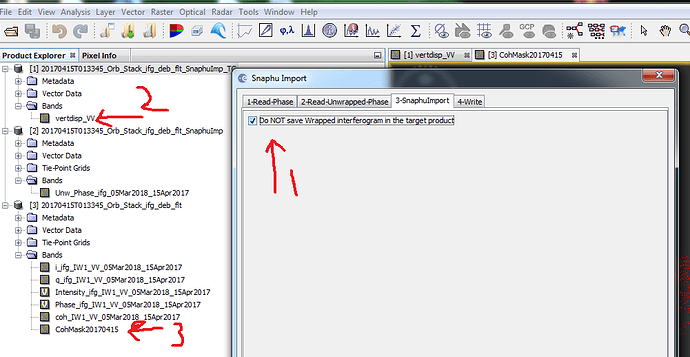hi every one,
i tried to measure land subsidence per year in my study area .
my steps are
1- download S1 SLC for 2014<2015<2016<2016
2- Split all products
3-Apply orbit file ,>back geocoding > Enhanced spectral diversity > interferogram > s1 TOPs debrust >Topophase removal> multi looking>goldstein phase filter> export to SNAPHU
-someone tell me that, I should use pairs with a short baseline
how can i build pairs? and what is the right sequence for land subsidence per year?
regards
I recommend using the S1 TOPS Coregistration tool for image pairs of successive acquisitions.AB, BC, CD, and so on.
Then apply the interferogram generation (including topigraphic phase removal), deburst and filter it, then unwrap it. In You can calculate their displacement and, in the end, stack all displacements within one year and calculate their sum.
AB, BC, CD,
Possible more clarification
and
if i used single product for every year ??? is that right?
Temporal decorrelation is probably too high to use image at a yearly base.
with ABCD i mean the single images you have. You create pairs of every subsequent ones. First+second, second+third, third+fourth,…
It is unlikely that you will get good results with one image per year (unless you are in arid regions without any vegetation cover).
Maybe these materials help you to understand the theories behind InSAR for subsidence monitoring: http://www.esa.int/About_Us/ESA_Publications/InSAR_Principles_Guidelines_for_SAR_Interferometry_Processing_and_Interpretation_br_ESA_TM-19
Many thanks Braun
Dear lbra
Dear ABraun
any clarification and update about the procedure of Sentinel SLC (AB+BC+CD+DE) for measure land Subsidence… What I do after apply coregistration of SLC pairs ?and how can compute the subsidence map of the images in total…
Please inform me update…
An example for multi-temporal InSAR analysis is given here: https://eo-college.org/resources/insar_deformation/
Especially the last couple of slides demonstrate the combination of multiple pairs.
how many images you took for each year?
Hello! I want to find average vertical displacement of 10 pairs so how can I find? as I have already find out pair by pair vertical displacement? Waiting…
this depends on how you created your interferograms. Do all slave images refer to the same master or did you make image pairs of two successive acquisitions?
This was lately discussed here: Interferogram averaging for DEM generation
I have one master and all other slave which are all pair to master one by one
so you can calculate the displacement for each pixel for a different time period.
Let’s say:
AB (12 days) -8 mm
AC (24 days) -12 mm
AD (36 days) -16 mm
that is -8/12, -12/24 and -16/36, thus -0.666, -0,5 and -0,444 mm per day.
Thank you I got. how can we perform this for whole product(pair/unwrapped interferogram)?
after unwrapping, you use “phase to displacement” to get a raster of displacement.
Afterwards, you can divide the raster by the number of days between the first and the second image to get the displacement per day per pixel. Do this with every product and in the end you can stack them all and compare.
Thank you so much
In Snaphu import i tick the option 1 as shown in figure, in 2 i find out vertical displacement and in 3 i mask out coherence. now i want to find masking out area with low coherence i.e vertical displacement *Coherence mask but these both are in different products, what should i do? please help me out
Hello sir! In Snaphu import i tick the option 1 as shown in figure, in 2 i find out vertical displacement and in 3 i mask out coherence. now i want to find masking out area with low coherence i.e vertical displacement *Coherence mask but these both are in different products, what should i do? please help me out
Did you try up? band extractor from optical tab and then import this band to be one object of the other product!!
no sir, how to do?
it’s explained in the previous post, first extract the band and then import it to be one of the other product’s object.
